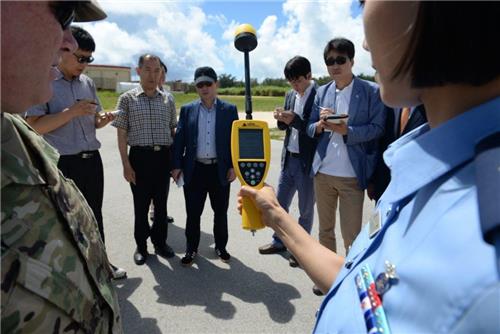(ATTN: UPDATES with U.S. military comment in 11th para, U.S. lawmakers' welcoming comment on THAAD in 15th para)
By Choi Kyong-ae and Defense Ministry Joint Press Corps
SEOUL, July 18 (Yonhap) -- The United States disclosed its advanced anti-ballistic missile battery in Guam to South Korean media on Monday to help allay fears about the health risks linked to the system's powerful X-band radar.
A pool of Korean reporters visited the Terminal High Altitude Area Defense (THAAD) battery in northern Guam, a part of Andersen Air Force Base, so they could check for themselves the major issues related to the electromagnetic waves emanating from the AN/TPY-2 radar and the noise level of the emergency generators.
Using equipment brought from Seoul, military officials of both the U.S. and Korea measured the levels of electromagnetic waves from the THAAD radar for the first six minutes at a point 1.6 kilometers away from the THAAD unit after it was activated. The measurement conditions in Guam were set similarly to those in Seongju, the selected site for South Korea's first THAAD.
The radar waves reached a maximum of 0.0007 watt per square meter, accounting for 0.007 percent of the 10 watts per square meter maximum permitted under Korean laws.
 This photo, taken on July 18, 2016, and provided by the U.S. Air Force, shows officials measuring the level of electromagnetic waves from the radar of a THAAD battery in Guam, with South Korean reporters watching and taking notes. (Yonhap)
This photo, taken on July 18, 2016, and provided by the U.S. Air Force, shows officials measuring the level of electromagnetic waves from the radar of a THAAD battery in Guam, with South Korean reporters watching and taking notes. (Yonhap)
Robert F. Hedelund, commander of U.S. Marine Corps Forces Korea, told reporters that the THAAD battery does not hurt the health and safety of the unit's operators, soldiers or residents nearby and that the safety standards that apply to the Guam THAAD unit are higher than those recommended by international standards. He said the Guam base's safety standards will be applied to Korea's THAAD battery.
Another U.S. military official on the U.S. Pacific territory said that as the U.S. has a duty to protect its own soldiers and residents in adjacent towns, every effort will be made to make sure the THAAD battery to be set up in Korea will be operated safely.
As for the noise level of generators near the THAAD radar, soldiers working at the site do have to wear earplugs, but the noise is no longer an issue at about 500 meters away, the commander explained.
The U.S. military said as Korea's THAAD system will get its power mainly from the commercial grid, not from emergency generators, soldiers and residents will not be affected by the noise.
 This photo, taken on July 18, 2016, and provided by the U.S. Air Force, shows reporters taking notes as a military official explains the THAAD system in Guam. (Yonhap)
This photo, taken on July 18, 2016, and provided by the U.S. Air Force, shows reporters taking notes as a military official explains the THAAD system in Guam. (Yonhap)
The join press corps' tour comes after residents of Seongju, 296 kilometers southeast of Seoul, strongly protested the decision announced by Seoul and Washington on July 8 to deploy THAAD in the rural county by 2017 to counter ever-growing nuclear and missile threats from North Korea.
The revelation of the Guam unit to civilians, the first time for a U.S. THAAD battery, is aimed at ensuring that the advanced antimissile system will pose no health risks to Seongju residents.
Given that the THAAD system was successful in intercepting incoming ballistic missiles in 13 tests, it will effectively defend South Korea from missiles from North Korea, the U.S. military said.
Last week the defense ministry conducted tests showing that electromagnetic waves from the radar of the country's two existing antimissile systems pose no health risks. The radar waves measured in the two systems were far lower than the permissible limit.
But the test results fell far short of persuading Seongju residents to accept the deployment plan.
Prime Minister Hwang Kyo-ahn and Defense Minister Han Min-koo visited Seongju on Friday but failed to alleviate the concerns that the residents have about THAAD's health risks. They were also trapped in a bus for over six hours as local protesters kept them from leaving the area.
 This photo, taken on July 18, 2016, and provided by the U.S. Air Force, shows S. Korean reporters attending a briefing by the U.S. military forces in Guam on its THAAD battery. (Yonhap)
This photo, taken on July 18, 2016, and provided by the U.S. Air Force, shows S. Korean reporters attending a briefing by the U.S. military forces in Guam on its THAAD battery. (Yonhap)
Meanwhile, U.S. Sen. Brian Schatz (D-HI), who is visiting Korea along with four other lawmakers from the Senate and House of Representatives, welcomed the decision recently announced by the two allies to deploy a THAAD system here, according to the foreign ministry.
THAAD, a core part of America's multilayered missile defense program, is designed to intercept incoming ballistic missiles at altitudes of 40 to 150 kilometers during the terminal phase of flight after detecting the missiles with a land-based radar system.
A THAAD battery consists of six truck-mounted launchers, 48 interceptors (eight per launcher), a fire control and communications unit, and an AN/TPY-2 radar.

No comments:
Post a Comment